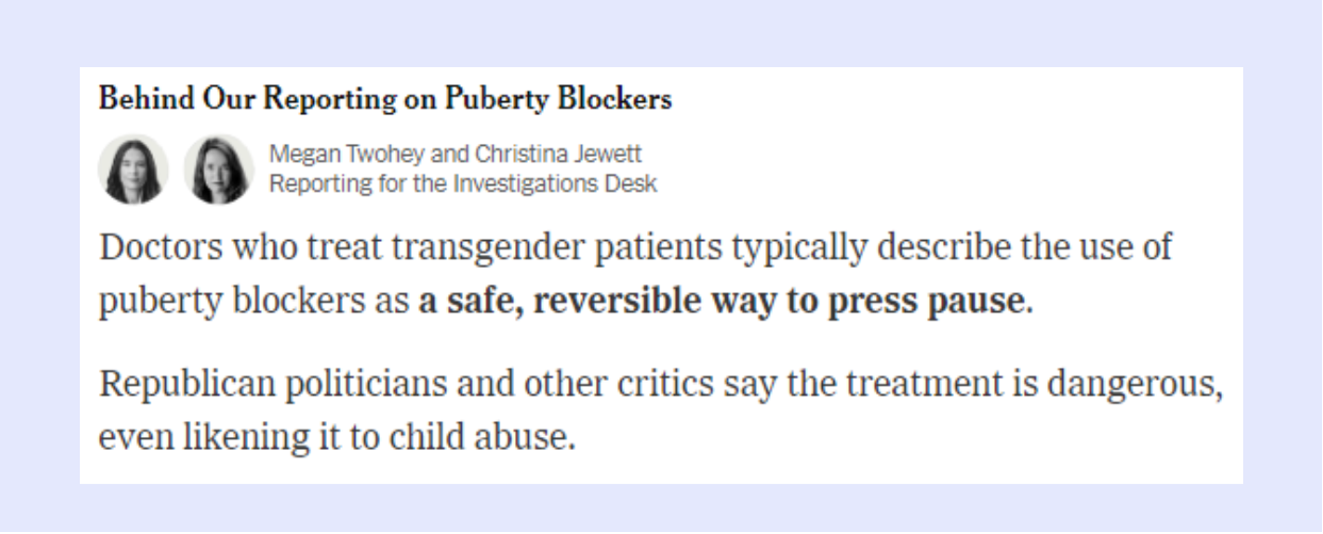The newspaper has a chance to use its coverage for good, by shining a light on the struggles and triumphs of marginalized communities, rather than contributing to a climate of discrimination and violence.
By: Serena Sonoma
For decades, legacy outlets like The New York Times have shaped public opinion and driven social change, often after being dragged there themselves. The Times’ difficult history covering the LGBTQ community and the early days of the HIV/AIDS crisis has echoed in its current struggles to accurately report on transgender people.
Prominent frontpage coverage has frequently missed the big picture of the trans community, choosing instead to hyper-scrutinize essential and mainstream medical care, undermining its support among readers who know next to nothing about this care, while laundering extremist talking points as legitimate concern. The Times’ coverage has elevated critics without alerting readers to their anti-LGBTQ, anti-trans histories and their coordination and connections to longtime anti-LGBTQ groups like Alliance Defending Freedom.
In its most prominent and inaccurate, biased coverage of transgender people and our essential healthcare, The New York Times has empowered the already powerful to do even more harm. The Times continues to refuse to acknowledge its responsibility in encouraging this harm, including in two pieces last week describing the growing number of states banning healthcare for trans youth and even adults.
The Times is reporting on a wildfire without acknowledging how its biased coverage is an accelerant in the spread.

The Times’ reporting is being weaponized against the trans community, and is therefore actively contributing to an ongoing climate of discrimination and violence. Just last week, Missouri Attorney General Andrew Bailey cited this flawed New York Times article by Emily Bazelon to justify an “emergency” order banning healthcare for transgender people of all ages in the state.
Missouri Attorney General Andrew Bailey’s blatantly unconstitutional order imposing new restrictions on gender affirming care for trans people of all ages cites coverage from the New York Times in justifying an 18 month waiting period for receiving care pic.twitter.com/AINdnQrDtT
— Ari Drennen (@AriDrennen) April 13, 2023
Anti-trans legislators and opponents of trans equality are now openly trumpeting the newspaper’s coverage as they push agendas against trans people and families. This care is safe, essential and supported by every major medical association, yet the Times’ coverage repeatedly and inaccurately treats the widely-held consensus in the medical and science communities as a “side” to be debated with anti-LGBTQ politicians like Bailey.

This false and inaccurate framing was spelled out to Times leadership in an open letter in February addressed to Philip B. Corbett, Associate Managing Editor for Standards, signed by more than 1,000 Times contributors. The Times contributors cited “serious concerns about editorial bias in the newspaper’s reporting on transgender, non-binary, and gender nonconforming people,” including “publishing reporting on trans children that omits relevant information about its sources.” The contributors note prominent articles that failed to report sources’ connections to longtime anti-trans groups: “Grace Lidinksy-Smith, was identified as an individual person speaking about a personal choice to detransition, rather than the President of GCCAN, an activist organization that pushes junk science and partners with explicitly anti-trans hate groups,” the contributors accurately flagged to the Times’ editor of Standards, also about Bazelon’s inaccurate piece.
(The contributors’ letter is wholly separate from a letter delivered the same day from more than 100 LGBTQ groups including GLAAD and notable names, also calling for the Times to address its biased reporting, meet with trans leaders, and hire more trans staff, calls which have gone unanswered.)
More than 100 organizations and leaders have signed a letter to the @nytimes demanding a stop to biased and irresponsible coverage of transgender people.
Today GLAAD was at the New York Times building to deliver the letter and send a clear message. https://t.co/IkQocps8fS pic.twitter.com/0xqk2aMHwi
— GLAAD (@glaad) February 15, 2023
The contributors accurately noted how opponents of transgender people have seized on the Times’ biased coverage in court documents and legislative hearings.
“The natural destination of poor editorial judgment is the court of law,” the Times’ own contributors wrote. Here is what that looks like:
- Missouri Attorney General Andrew Bailey’s baseless emergency order cites Emily Bazelon’s piece to justify extreme waiting periods for essential healthcare.
- Texas lawmakers quoted Bazelon’s report to target families of trans youth over their private, evidence-based healthcare decisions.
- The Times’ front page piece on puberty blockers was cited in a lawsuit to require schools to out LGBTQ students.
Emily Bazelon’s piece was cited by Texas to be able to justify launching investigations into the families of trans children. Megan Twohey’s piece on puberty blockers was cited in a lawsuit to mandate forced outing of LGBTQ students in schools.
— Alejandra Caraballo (@Esqueer_) February 16, 2023
- The Times’ reporting on trans youth and its reputation as the “paper of record” was used to justify a bill pending in the Nebraska legislature to criminalize healthcare for trans youth. The legislature has advanced the bill banning this essential care, over the objections and real life experience of its own out LGBTQ colleagues.
“I can’t stop thinking about the parents,” State Sen. John Fredrickson tearfully said, reading a letter from a constituent who said her son would have taken his own life if he did not have access to affirming care when he was a teen. Sen. Fredrickson is the first out gay man elected to the Nebraska legislature.
Senator John Fredrickson (@JohnforNE), the first openly gay man to serve in the Nebraska Senate, stood in front of the and told trans people through tears, “Heads up. Chins up. We’re survivors. Me standing in this room is proof of that.”
The filibuster there continues. pic.twitter.com/cZm8UI5Zde
— Erin Reed (@ErinInTheMorn) March 23, 2023
The Times did not cover the testimony or acknowledge its reporting had been cited by anti-trans activists in the state to push bans on essential healthcare.
- 15 state attorneys general filed an amicus brief in defense of Alabama’s discriminatory, harmful and misnamed bill which would make providing essential healthcare to trans youth a felony, including puberty blockers, which have been prescribed safely for years to cisgender patients. The brief cited three New York Times articles to validate its support of the law and included the Times articles’ “just asking questions” and “both sides” language.

The brief, posted by disinformation spreader Texas Attorney General Ken Paxton, who has a documented history of advocating against transgender and all LGBTQ people with lies and falsehoods, repeats the Times’ inaccurate and harmful framing:
“Most recently the New York Times Magazine published an article titled, “The Battle Over Gender Therapy,” which recognized that “[m]ore teenagers than ever are seeking transitions, but the medical community that treats them is deeply divided about why—and what to do to help them.” Factcheck: The medical community is not “deeply divided” – every major medical association and world health authority supports transgender medical care, statements here.
Paxton and fellow extremist attorneys general also cited the Times’ Azeen Ghorayshi and her piece and inaccurate claim about “a fraught debate” over hormone therapy. Factcheck: research shows demonstrable benefits of hormone therapy and “fraught” is a term most frequently used by cisgender writers the Times has hired and who repeat fearmongering and lies about transgender people.

The brief cites the Times’ frequent LGBTQ equality critic Ross Douthat and his baseless claim that there is “increasingly vigorous debate around adolescent medical interventions.” Factcheck, again, every major medical association has issued statements of support for transgender health care, at least 29 associations and counting.

In February, ACLU lawyer Chase Strangio, who fought and won the first case for transgender equality before the U.S. Supreme Court, described the Times’ coverage of transgender healthcare as “incredibly harmful.”
“Just because something can be debated doesn’t mean it should be,” Strangio wrote. “And when something as essential to survival as whether health care for a group of people is legitimate becomes the subject of widespread debate, those so-called debates have very significant material consequences.”
How has the Times responded to its contributors’ critiques, such as its reporting failures cozily quoted in briefs promoted by anti-LGBTQ extremists like Attorneys General Bailey and Paxton?
The Times has yet to respond to its own colleagues’ specific critiques and justifiable alarm about the storytelling failures and the harms it is clearly causing. The Times has yet to acknowledge how its reporting has been weaponized by anti-trans activists. Times leadership did falsely charge that colleagues were in cahoots with LGBTQ organizations, conflating both the contributors’ and the coalition letters as “activism” it can apparently ignore. Factcheck, there were two letters to the Times critiquing its coverage, and the only coordination was the letters were delivered on the same day, separately and to different Times leaders.
The Times is seemingly ok with anti-trans activists quoting its stories to codify harm against trans people. The Times has not acknowledged that its problematic stories omit the anti-trans history and anti-trans groups’ connections to key sources, creating massively misleading narratives. But colleagues critiquing the same stories were called into meetings and threatened with “letters in their files.” The Times appears far more vigorous in pushing both sides baloney storytelling and crushing internal dissent than about honest criticism, or the pursuit of accurate, curious, compassionate reporting on a community that direly needs media to try to understand.
Recently, The Washington Post published a series of stories that every reporter, editor and leader of the New York Times should read, and learn from.
In a sweeping Washington Post-KFF poll, 45% of trans adults said school made them feel unsafe. https://t.co/zbNEY8ZIMA
— The Washington Post (@washingtonpost) April 12, 2023
The Post’s reporting reflects what trans leaders and writers have been calling on the Times to do: focus more on the lives of trans people, highlighting their unique perspectives and barriers. Hear from this little-known group in their own words, rather than 15,000 words questioning and undermining nuanced and private healthcare with falsehoods from anti-trans politicians, while hiding the documented animus of other sources. At The Washington Post, trans voices and experiences are elevated instead, in stories about their lives.
At 11 a.m., I’ll be talking about our Trans in America series, which centers the perspectives of the community through one of the largest ever randomized surveys of trans adults https://t.co/ltjYzoetmZ
— Fenit Nirappil (@FenitN) March 24, 2023
The Post’s accurate storytelling counteracts harmful stereotypes perpetuated by extremist politicians and pundits, and contributes to a greater understanding of the full diversity of the trans community. The Post’s reporting on its joint survey of 515 transgender people, notes how the overwhelming majority of trans people are happier having transitioned, how many knew they were trans from an early age, and how older trans Americans have been living, surviving and thriving, literally for decades, with the healthcare that so many states are now so hellbent on banning, even for transgender adults.
Journalists have a responsibility to report on issues that affect marginalized communities, and to do so in a way that is accurate to the facts and to the preponderance of research and consensus, and above all, reflective of the community’s expressed realities.
Moreover, it is important for us as a society to recognize the harm perpetrated by extremist lawmakers and media that let them get away with it. The Times’ misinformed coverage highlights the need for greater education about the trans community and basic storytelling practices that demand clarity when sources have agendas. There is a deep need for a more nuanced and compassionate public discourse around gender.
The New York Times can learn from its competitors and from trans leaders to more accurately shine a light on the struggles and triumphs of marginalized communities, rather than contributing to a climate of discrimination and violence. They can start by owning responsibility for its failures and listening to the community they harmed. It is up to all of us to create a society that is more inclusive and accepting for everyone.












